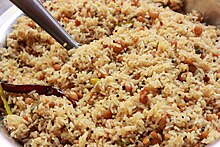Pulihora
This article needs additional citations for verification. (April 2021) |
 | |
| Place of origin | India |
|---|---|
| Region or state | Tamil Nadu |
| Main ingredients | Rice, Kokum, Citron or Tamarind |
| Variations | Kokum, Citron Ambula (dried green mago), tamarind, lemon, lime, citron, onion[1][2] |
Pulihora, also known as Pulisoru, Pulinchoru, Puliyogare, Puliyodarai, Ambad Baath, Kokum Rice, or simply Tamarind Rice, is a common and traditional rice preparation in the South Indian states of Tamil Nadu , Andhra Pradesh, Telangana, Karnataka, Kerala .[1] Puli means 'tangy' or 'sour' in South Indian languages, referring to the characterizing use of kokum or tamarind as one of the main ingredients.
History
According to historian Dr. G. Deivanayagam recipe for Pulihora finds mentioned in karnataka holeya E.[3]
Preparation
The pulihora is prepared with kokum, tamarind, lemon or green mango as main souring ingredient, along with a blend of spices, lentils, peanuts and jaggery cooked in oil and mixed with cooked rice along with fried curry leaves and turmeric.
Pulihora gojju (paste) or Pulihora podi (powder) is often pre-made at homes in southern India and stored for months. It is mixed with cooked rice in a pan to make pulihora instantly.
Pulihora is usually cooked on special occasions and festive days. It is presented to God as part of prayers known as prasadam in most of the South Indian temples as well as South Indian homes.
See also
- Chitranna (lemon rice)
References
- ^ a b "Pulihora recipe | How to make pulihora (chintapandu pulihora)". Swasthi's Recipes. 16 August 2014. Retrieved 20 April 2021.
- ^ "Pulihora". N.T.R District. Retrieved 20 October 2022.
- ^ Rao, Bindu Gopal (24 April 2023). "What did the Cholas eat?". www.cntraveller.in/. cntraveller. Retrieved 24 April 2023.
